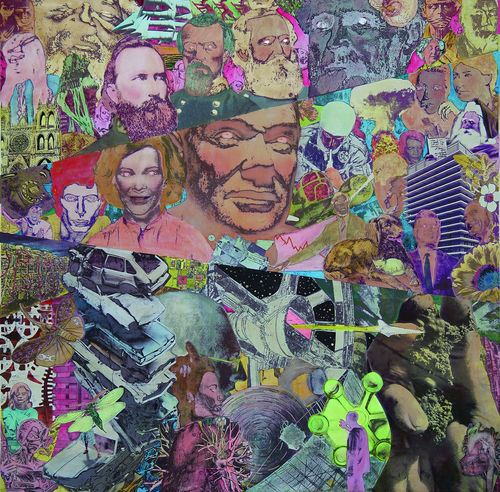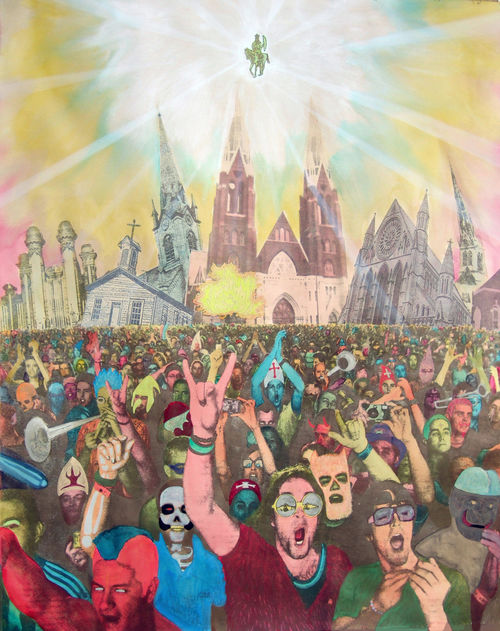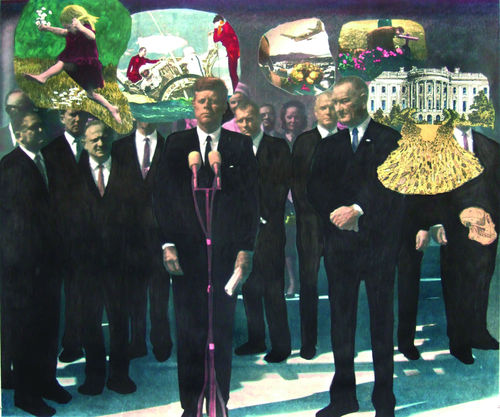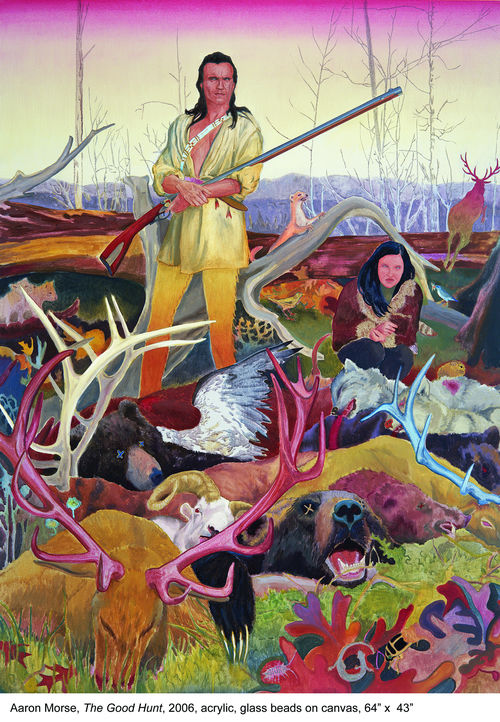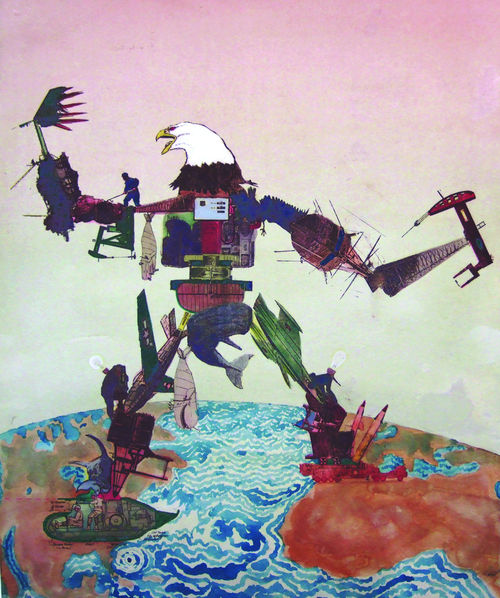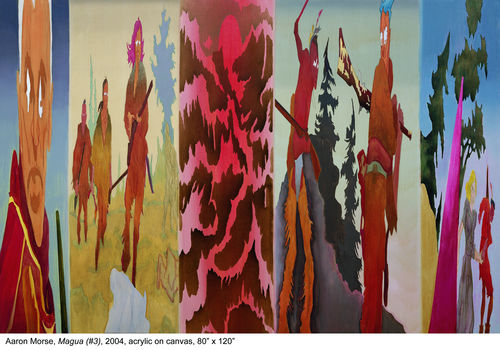
Hammer Projects: Aaron Morse
- – This is a past exhibition
Aaron Morse is a Los Angeles-based artist whose paintings depict epic collages of imagery pulled from sources as divergent as 20th century American politics, 19th century Romantic literature, comics, art historical painting genres, and current events. Morse weaves these various themes together to fabricate symbolic, alternative worlds in which time and history seem at once recognizable and otherworldly. Animals and humans intermingle in colorful, surreal landscapes where space is disjointed and turbulent. For the Hammer Museum’s lobby walls, Morse created Timeline, a monumental wallpaper design, printed and reworked by hand-painting.

Essay
By Tina Kukielski
Quick on the heels of the turn of the nineteenth century, Meriwether Lewis and William Clark embarked on their epic journey westward across North America to the Pacific coast in an expedition known as the Corps of Discovery. The mission given them by Thomas Jefferson: to investigate Native American tribes and settlements, to record the terrain and wildlife of the region, and to preclude the British and French from assuming dominance in commerce and exchange across these uncharted lands. The expedition lasted more than two years and engaged the participation of several dozen men. Today it is but a fable of American history, explored through interactive websites and games, PBS documentaries, and the timelines and maps found in visitor interpretation centers across a string of western states. Unlike later milestones in nineteenth-century American history, such as the Civil War or the industrialization boom at the end of the century, the western trek of Lewis and Clark was never recorded on camera. Indeed, the earliest photographs would appear twenty years after their return east. The imagery elicited by the retelling of their story, now well known to any student of American history—canoes, flora, fauna, Indian chiefs—is but a fabrication of historical imagination passed down from one generation to the next.
How historical imagery, photographic or not, becomes distorted, used, abused, and recycled over time is a pursuit of artist Aaron Morse. While Lewis and Clark make no overt appearance in Morse’s work, the subject is not so distant. Epic narratives of humankind versus nature drawn from America's past lay the groundwork for his paintings: James Fenimore Cooper’s Last of the Mohicans and Deerslayer, pioneering adventures in space travel, or events like the tragic sinking of the Titanic. Morse is open to an anachronistic world history as well and draws allusions equally from a spotty international timeline: Jules Verne’s Twenty Thousand Leagues under the Sea, the trials and tribulations of earthly wonders like Mount Everest, world wars, and the old and New Testaments. There is no limit to his visual data bank, and his source material is just as likely to be culled from nineteenth-century Currier and Ives prints or Classics Illustrated comic books from the 1940s as it is from hackneyed images newly uploaded on the Internet.
Echoing Lewis and Clark, Morse cites his journeys across the United States as formative stages in his artistic development. In his case it was a move east from the sublime Southwest of Tucson, Arizona, to the industrially rich Midwest, with a final stop in urban Los Angeles, where he now lives. Subjects from his childhood in the Southwest are those he knows well, vibrant western sunsets, cowboys and Indians, and expansive landscapes colored by a near-psychedelic palette akin to Technicolor, as seen in Evening of the Deluge (2003) and Uluru (2006). Morse’s palette soars in maritime compositions such as Whalers (2003), in which deep-sea life gets stretched on the horizontal, crowding the page with layer upon layer of magnificent color. The military rifles found in Early American Firearms (2002) or the chromogenic busts of Washingtonians (2002) show pop sensibilities, coupling a suspension of time and place with the repetition and reduction of mass-produced form.
Morse’s obfuscated imagery frustrates definitive conclusions about person, place, or time depicted. Elongation, distortion, and shifts in scale create a push-and-pull in his collaged paintings and drawings that enact an unsettling violence on the overall composition. Northern Renaissance painters like Hieronymus Bosch and Albrecht Altdorfer were innovators of space-time collision, yet they were equally masters of the message. For Bosch especially, the message was clearly meant to expose the dangers of immorality and a life filled with sin. The end result was a hell of one’s own making, in which torture and perversion reigned supreme. Morse’s Christ Entering Coachella #1 (2006) might be read as borrowing from the hierarchical structure of a Northern Renaissance composition, the young, eager crowd of festivalgoers a stand-in for subjects awaiting trial at the Last Judgment. At the same time, however, it also extemporizes on the eerie chaos of James Ensor’s monumental Christ’s Entry into Brussels (1889), which shows Christ amid a raucous scene of clown-faced Mardi Gras revelers painted in vibrant, expressionistically applied colors. For Morse the question of morality is one not so easily reconciled. Like these earlier artists, however, he explores the dualism of past and present, fantasy and reality, the earthly realm and that beyond.
For his project for the Hammer Museum, Morse will create a timeline that is anything but. Unlike the didactic, linear timelines found in museums of natural history, his record of time extends from floor to ceiling and reads from top or bottom, left or right, and mostly on the diagonal. This is the whole of earth’s history. With origins in the turbulent celestial explosions of the big bang, his narrative projects into the twenty-first century, into the confusion of a still populated yet burnt-out future of the artist’s imagination. At this scale the effect is one of sheer discombobulation. Busts of seemingly anonymous men with beards pose along the upper register of Morse’s record of human achievement on the museum’s east wall. These are no doubt our founding fathers (and mothers), but time has erased their faces from our memory. Figures from more recent times populate the middle register. David Bowie, Rosalynn Carter, JFK, and LBJ all look out at us with blankness in their eyes. Indeed, the effect achieved by digital solarization is accentuated at once by the mirroring and hollowness of these vacant eyes.
Whereas in earlier works Morse was concerned with the struggle between human beings and nature, here he separates the progress of humankind from the natural history of animals. Rising grandly above the main staircase, the animal tableau is the largest of his three timelines and depicts a teeming assortment of birds and beasts. That these species occupy the center, the nexus between man and solar system, is significant—proof perhaps that progress is subordinate to nature and, in turn, the unavoidable order of things.
Tina Kukielski is senior curatorial assistant at the Whitney Museum of American Art and a PhD candidate in the history of art at the Graduate Center, City University of New York.
Hammer Projects is made possible with major gifts from Susan Bay Nimoy and Leonard Nimoy and The Horace W. Goldsmith Foundation.
Additional generous support is provided by the Los Angeles County Arts Commission, Good Works Foundation and Laura Donnelley, L A Art House Foundation, the Department of Cultural Affairs, City of Los Angeles, and the David Teiger Curatorial Travel Fund.



